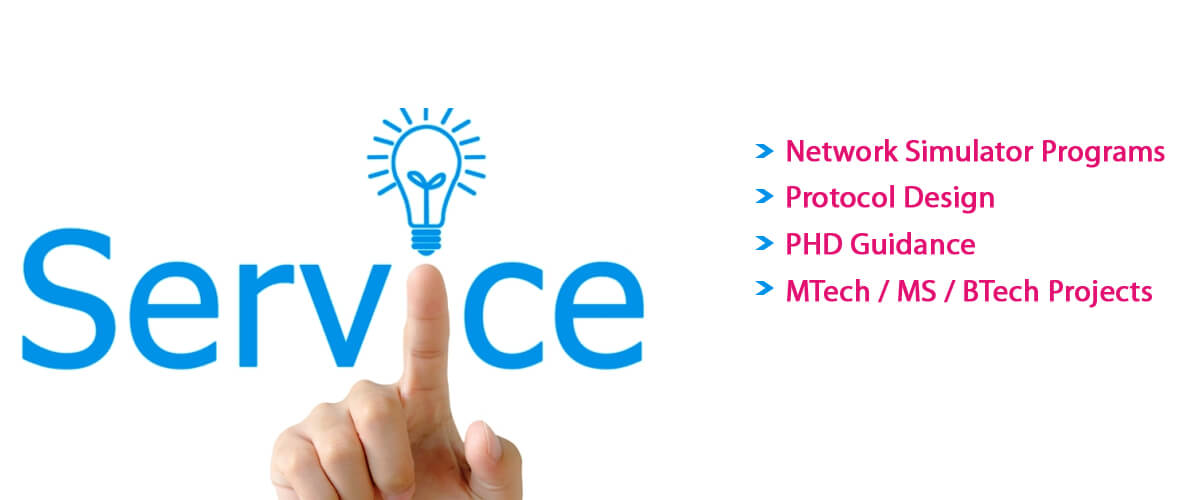Telecommunication Projects Examples Using NS2
Telecommunications Project Samples Using NS2 that focussed on different aspects of network protocols, communication systems, and network performance are shared here. Choosing a good topic is regarded as one of the most difficult tasks that scholars face. We offer you every assistance in selecting a brilliant research topic, so if you require guidance, please contact us. We will provide you with the best project results. To learn more about our service, send a message to ns2project.com.
- Performance Analysis of TCP Variants in Telecommunication Networks
- Project Focus: mimic diverse TCP variants like TCP Reno, TCP Tahoe, and TCP Vegas in a telecommunication network and compare their performance.
- Objective: evaluate how diverse TCP congestion control mechanisms impacts the performance of telecommunication networks in changing conditions.
- Metrics: Throughput, packet loss, latency, and congestion window size.
- Voice over IP (VoIP) Performance in Telecommunication Networks
- Project Focus: Mimic a VoIP communication scenario in diverse telecommunication networks like Wi-Fi, LTE, and 5G.
- Objective: measure the performance of VoIP in terms of latency, jitter, and packet loss in numerous network conditions.
- Metrics: Delay, jitter, packet loss, and Mean Opinion Score (MOS) for VoIP quality assessment.
- LTE and 5G Network Simulation in NS2
- Project Focus: Replicate LTE and 5G telecommunication networks in NS2 to learn on their performance based on throughput, handover, and QoS.
- Objective: Relate LTE and 5G networks in terms of bandwidth efficiency, data rate, and latency.
- Metrics: Network throughput, latency, handover delay, and packet delivery ratio.
- Traffic Management in Telecommunication Networks Using QoS
- Project Focus: Replicate a QoS-based traffic management system for telecommunication networks to selects real-time traffic such as VoIP, video over non-real-time traffic like web browsing.
- Objective: Make sure QoS for diverse traffic types while sustaining an optimal network performance.
- Metrics: Bandwidth utilization, delay, jitter, and packet loss for different traffic types.
- Packet Scheduling in 4G/5G Telecommunication Networks
- Project Focus: Execute and relate the packet scheduling techniques like Round Robin, Proportional Fair, and Maximum Throughput in 4G/5G networks.
- Objective: Learn the effects of different packet scheduling approaches on the overall performance of telecommunication networks.
- Metrics: Packet scheduling efficiency, throughput, fairness, and delay.
- Handover Mechanisms in Mobile Telecommunication Networks
- Project Focus: Replicate horizontal (intra-network) and vertical (inter-network) handovers among diverse telecommunication networks such as Wi-Fi, LTE, and 5G.
- Objective: Evaluate the effects of handover mechanisms on network performance and service continuity.
- Metrics: Handover delay, packet loss during handover, throughput, and signal strength.
- Energy-Efficient Communication in Telecommunication Networks
- Project Focus: Execute an energy-efficient routing and transmission protocols for mobile telecommunication networks.
- Objective: Learn on how energy-aware communication protocols can minimize energy consumption while sustaining network performance.
- Metrics: Energy consumption, network lifetime, throughput, and delay.
- Telecommunication Network Security Simulation
- Project Focus: Replicate security protocols such as IPsec, SSL/TLS, and intrusion detection systems (IDS) in telecommunication networks.
- Objective: evaluate on how security protocols affects network performance and secure the data from security threats.
- Metrics: Encryption overhead, latency, data integrity, and packet delivery ratio.
- Multi-Access Edge Computing (MEC) in Telecommunication Networks
- Project Focus: To mimic a telecommunication network with Multi-Access Edge Computing (MEC) to mimic latency and enhance service delivery by processing data closer to the user.
- Objective: Learn on how MEC improves the performance of real-time applications such as video streaming and online gaming.
- Metrics: Latency, edge node utilization, bandwidth savings, and service response time.
- Congestion Control in Telecommunication Networks
- Project Focus: Execute congestion control techniques such as RED (Random Early Detection), AQM (Active Queue Management), and TCP congestion control in a telecommunication network.
- Objective: Learn on how congestion control mechanisms enhance network performance and mitigate packet loss.
- Metrics: Packet drop rate, queue length, latency, and throughput.
- Telecommunication Network Optimization Using Software-Defined Networking (SDN)
- Project Focus: Replicate a telecommunication network using SDN to enthusiastically enhance traffic flow, routing, and resource allocation.
- Objective: Learn on how SDN enhance network management, traffic routing, and QoS in a telecommunication network.
- Metrics: Network throughput, latency, packet delivery ratio, and routing efficiency.
- Video Streaming Performance in Telecommunication Networks
- Project Focus: Mimic video streaming in a telecommunication network and measure the performance of Adaptive Bitrate Streaming (ABR) approaches.
- Objective: understand on how ABR enhance video quality and minimize buffering in changing network conditions.
- Metrics: Video quality (resolution), buffering time, delay, and bandwidth utilization.
- Telecommunication Network Simulation for Smart City Applications
- Project Focus: Mimic a telecommunication network for smart city applications like traffic monitoring, public Wi-Fi, IoT devices to measure its scalability and performance.
- Objective: Learn on how telecommunication networks support large-scale IoT executions and real-time applications in smart cities.
- Metrics: Network scalability, throughput, delay, and device connectivity.
- Telecommunication Network Resource Allocation Using Game Theory
- Project Focus: Execute game-theoretic resource allocation techniques in a telecommunication network to enhance spectrum usage and network resources.
- Objective: Measure on how game theory can enhance resource sharing and fairness between network users.
- Metrics: Resource utilization, fairness index, network efficiency, and throughput.
- Telecommunication Network Simulation for Disaster Recovery
- Project Focus: Replicate a telecommunication network for disaster recovery, in which nodes form an ad-hoc network in the absence of infrastructure.
- Objective: Understand the performance of delay-tolerant networks (DTNs) and ad-hoc networks in a disaster recovery scenario.
- Metrics: Message delivery ratio, delay, network survivability, and routing overhead.
- Spectrum Sharing in Cognitive Radio Telecommunication Networks
- Project Focus: Replicate spectrum sharing mechanisms in cognitive radio telecommunication networks in which secondary users opportunistically use unused spectrum.
- Objective: Learn on how cognitive radio networks enhance the spectrum efficiency and overall network performance.
- Metrics: Spectrum utilization, throughput, interference, and packet delivery ratio.
- Telecommunication Network Protocol Comparison
- Project Focus: Compare the performance of different network layer protocols like IP, MPLS, and ATM in a telecommunication network.
- Objective: Measure on how different protocols affect the performance of telecommunication networks based on speed, efficiency, and reliability.
- Metrics: Packet delivery ratio, delay, jitter, and throughput.
- Telecommunication Network Topology Design and Optimization
- Project Focus: Mimic different network topologies such as star, mesh, ring in a telecommunication network and evaluate their effects on performance.
- Objective: Learn on how diverse network topologies impacts throughput, latency, and reliability in telecommunication networks.
- Metrics: Network throughput, delay, packet loss, and fault tolerance.
- Delay Tolerant Telecommunication Networks (DTNs)
- Project Focus: Replicate a DTN-based telecommunication network in environments with intermittent connectivity such as in rural areas, space communications.
- Objective: To learn on how delay-tolerant routing protocols like Epidemic Routing or Spray and Wait can enhance message delivery in challenged networks.
- Metrics: Message delivery ratio, delay, routing overhead, and buffer occupancy.
- 5G mmWave Communication Simulation in Telecommunication Networks
- Project Focus: Replicate 5G millimeter-wave (mmWave) communication in a telecommunication network to learn its performance in terms of speed and coverage.
- Objective: evaluate on how mmWave communication enhance data rates and how obstacles and distance impacts the network performance.
- Metrics: Throughput, signal-to-noise ratio (SNR), coverage range, and packet delivery ratio.
In this simulation, we had successfully implemented the telecommunication projects examples by using the ns2 tool. We also explore the more information regarding the telecommunication in other simulation settings.







